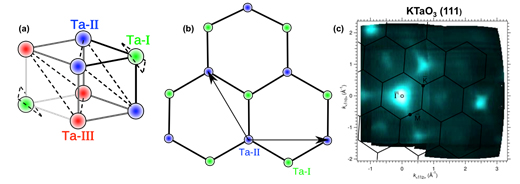2D metallic states are highly promising for the microelectronics of tomorrow. Researchers managed to create such state with hexagonal symmetry at the bare surface of several insulating oxides.
Researchers from several laboratories of University Paris-Sud (CSNSM, IEF, LPS, UMR-Thalès) and the CASSIOPEE beamline at SOLEIL synchrotron showed previously that 2D metallic states can be created at the bare surface of several transparent insulating oxides, such as SrTiO3 or KTaO3. This is very interesting, as these materials belong to the family of transition-metal oxides. These oxides have remarkable properties, such as high-temperature superconductivity for copper oxides, giant magnetoresistance for manganese oxides, multi-ferroelectricity for bismuth ferrites, or photocatalitic capacity for titanates. One can envision using the surface metallic states to control the properties of the bulk material, or even to create new properties by confining the electrons in a nanoscale slab beneath the surface. These 2D metallic states are thus promising for the microelectronics of tomorrow.

Confining electrons beneath the surface of insulating oxides offers another, very appealing possibility: by choosing the cleaving direction of the crystal, one can obtain specific geometries for the 2D crystal lattice at the surface, and thus tailor the topology of the confined electronic state. Thus, as illustrated in the picture above for a cubic crystal, which is a structure common to almost all oxides, a surface perpendicular to the long diagonal of the cube, also called the (111) direction, will show a hexagonal symmetry. Moreover, if the electrons were confined only within the first two layers along the (111) direction, they would experience an in-plane arrangement of atoms formally equivalent to the so-called “honeycomb” lattice. This lattice is exactly the same of the celebrated graphene, and is responsible of many of the unique properties of this material. Thus, combining the crystal symmetries at different surfaces of remarkable oxides with the confinement of the electrons on these surfaces could lead to new properties of electrons in matter, as several recent theories predict.
That’s precisely the approach that scientists from CSNSM took this time. Using techniques they had already developed to create 2D electron gases on oxides surface, they succeeded in creating a 2D metallic state at the (111) surface of KTaO3. By illuminating this surface with the synchrotron radiation at CASSIOPEE beamline, and measuring directly the electrons ejected due to the photoelectric effect (whose explanation, due to Einstein, gave birth to Quantic Mechanics a century ago), the researchers showed that the distribution of electronic states at the surface lattice had indeed hexagonal symmetry. This kind of electronic structure is unprecedented among all 2D metallic states known so far on oxides. Even though it is still necessary to prove that electrons can be confined on the two upper layers of the (111) surface, these results are fundamental. They pave the way to create new 2D metallic states combining the physical richness of transition-metal oxides with the extraordinary properties of graphene-like structures.
